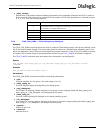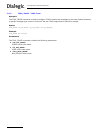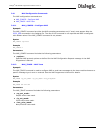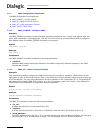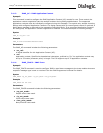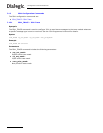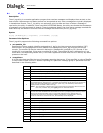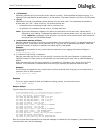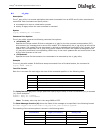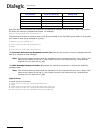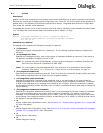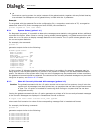
163
Dialogic
®
DSI SS7MD Programmer’s Manual Issue 3
• -f<filename>
Optionally specifies a file to which all screen output is written. If the specified file does not exist, it is
created. If the specified file already exists, it is overwritten. The data is stored in the file in ASCII format.
• -t[t|d]
Specifies the format of timestamp values derived from the host clock. The timestamp information is
printed after the “S7L:” label in the log. The format options are:
— -tt specifies short timestamp format, that is, the time only
— -td specifies full timestamp format, that is, the date and time
Note: Since the timestamps related to this option are derived from the host clock, values can be
affected by host loading. Timestamping relative to the internal board clock, set using bits 5 or 6
of the <options> parameter in the -o option, can provide more precise values when used with
monitored links on DSI SS7MD Boards.
• -n<maximum number of files>
Sets the maximum number of log files to be generated. You can specify that S7_log generate between 2
and 99 log files. If this option is not specified, up to 5 log files will be generated by default. When the
maximum number of log files is reached, the oldest log file is discarded.
Example
The following command line entry would cause a maximum of ten logging files named s7log.txt ...
s7log.txt.9.
s7_log -fs7log.txt -n10
• -s<maximum log file size in kilobytes>
Sets the maximum log file size. You can specify a maximum log file size of between 1 kilobyte and
100,000 kilobytes. If this option is not specified, the maximum log file size is set to 1000 kilobytes by
default.
When the maximum log file size is reached, it is renamed to <filename>.txt.1 and a new log file is
created. This procedure is repeated each time the log file reaches the specified maximum size.
Example
The following command line entry would cause log files (prefixed with s7log.txt) to be created with a
maximum size of 1000 kilobytes:
s7_log -fs7log.txt -s1000
Example
To run s7_log as module ID 0xef and enable all tracing options, the command line is:
s7_log -m0xef –o0xff1f
Sample Output
Typical output from s7_log is as follows:
S7_LOG: Message monitor (C) 1998-2002 Dialogic Corporation
=======================================================
S7_log : mod ID=0xef, options=0xaf0d
S7L:I0000 RSI_MSG_LNK_STATUS : Link 0 now down
S7L:I0000 RSI_MSG_LNK_STATUS : Link 0 now up
S7L:I0001 RSI_MSG_LNK_STATUS : Link 0 now down
S7L:I0001 RSI_MSG_LNK_STATUS : Link 0 now up
S7L:I0000 LIU Status : id=0 IN SYNC
S7L:I0000 LIU Status : id=0 PCM OK
S7L:I0000 Level 2 State : id=0 INITIAL ALIGNMENT
S7L:I0000 LIU Status : id=0 IN SYNC
S7L:I0000 LIU Status : id=0 PCM OK
S7L:I0001 Level 2 State : id=0 INITIAL ALIGNMENT
S7L:I0000 Level 2 State : id=0 ALIGNED READY
S7L:I0000 Level 2 State : id=0 IN SERVICE
S7L:I0000 MTP Event : linkset_id/link_ref=0000 Changeback
S7L:I0000 MTP Resume, dpc=00000001
S7L:I0000 M t0708 i0000 f23 d1d s00 p000000007fff
S7L:I0000 M t0708 i0000 f23 d1d s00 p00007fff0000
Each line of text that corresponds to a received message is prefixed by S7L:I<instance>, the instance being
recovered from the received message.



